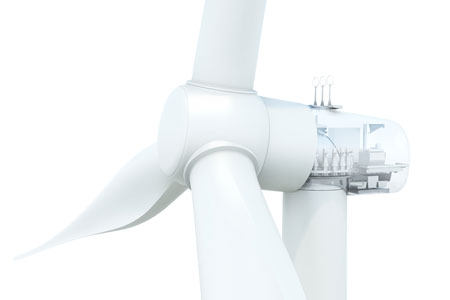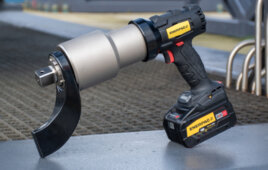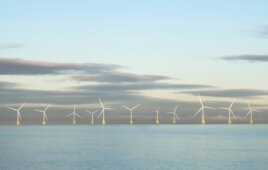A wind turbine needs yaw brakes to hold the rotor facing into the wind. If the turbine is not facing directly into the wind, it is not producing at full capacity. When wind direction changes, a turbine’s controls instruct its yaw motors to reposition the nacelle.
“In theory, this could be handled by one large yaw motor, but this would be problematic from a functional point of view,” said Andreas Gotfredsen, head of the yaw group at Siemens Wind Power and Renewables Division’s technical engineering department. “Although more motors drive the cost up, several work better than one.”
At Siemens, all turbines are fitted with the optimal yaw capacity for the load envelope of the turbine, according to Gotfredsen. That is, the harsher the conditions the turbine faces, the more yaw capacity it needs. Then too, a smaller diameter yaw ring requires more torque and a higher gear ratio, assuming similar-size rotors.
To illustrate, Siemens’s latest turbines, from its D3 platform, use 12 x 1.5 kW yaw motors, while the turbines from its large offshore D7 platform, use 16 yaw motors—relatively less from a megawatt point of view. This difference is due to comparatively less capacity needed per motor because the yaw-ring diameter is larger, said Gotfredsen.
Despite the difference between onshore and offshore wind environments, there is not necessarily a difference in the motors and drives of the turbines.
“An offshore wind turbine is completely sealed from outside influences, such as the higher humidity in offshore,” said Gotfredsen. “There is no difference between Siemens D3 and D7 platforms, they have the exact same yaw motor design. This provides us with a greater choice in suppliers and greater spare-part flexibility throughout turbine lifetime.”
An emerging development in motors and drives that will be useful for offshore wind: simplify, simplify, simplify.
“We strive to simplify our turbines as much as possible to reduce moving parts, which increases reliability,” said Gotfredsen. He sees the same trend in Siemens’s competitors, and expects the trend to continue.
Yaw systems are also being simplified. For instance, Siemens’s direct-drive turbine features a frictional sliding bearing as opposed to one with rolling elements.
Competitors differ in the placement of yaw-ring gears. Some gear teeth are machined on the inside and some on the outside of the yaw bearing. There is not much change as far as concept goes, but the placement is a design choice for different reasons.
One trend that may become more popular with competitors could be the use of yaw motor frequency converters, Gotfredsen predicted. This would help companies trim their power consumption.
Filed Under: Components, Featured, Nacelle, News, Pitch & yaw, Turbines





